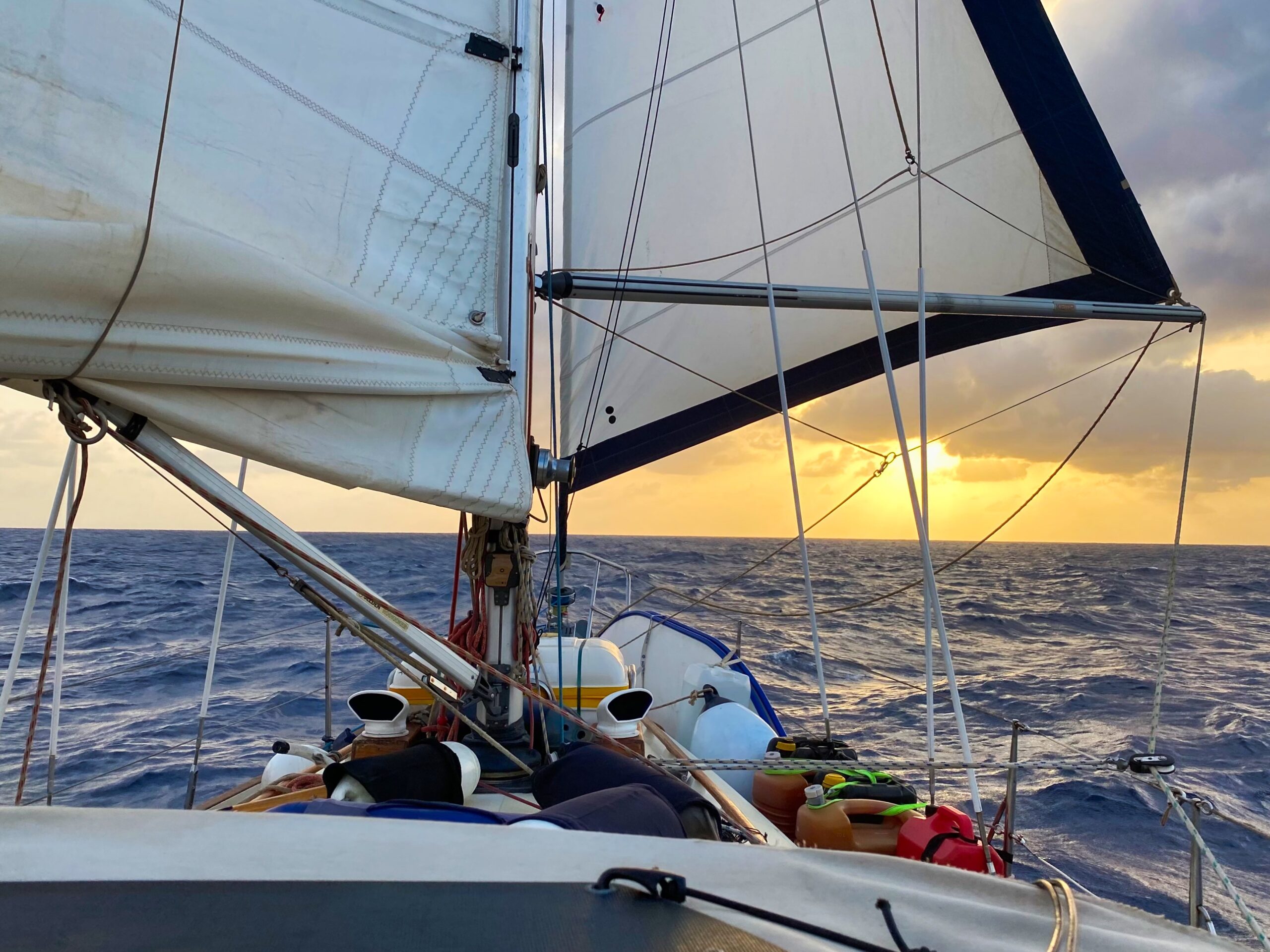Les Saintes are a group of green, steeply rising islets that enclose a perfect anchorage. The yachts moored here are correspondingly numerous. The wooded mountain flanks are dotted with elegant, red-roofed houses whose wide verandas offer views of an emerald green sea. To the north lies Guadeloupe, whose outline is reminiscent of a somewhat misshapen butterfly. Rain clouds hang from the high mountain peaks. It is about 20 nautical miles to Point-à-Pitre, the island’s capital. But we prefer the dreamy archipelago of Les Saintes to the hustle and bustle of Point-à-Pitre.
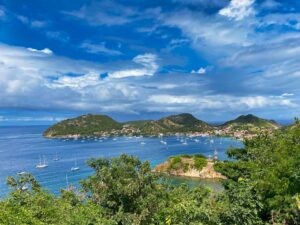
Iles les Saintes south of Guadeloupe.
Caribbean idyll
This is how you imagine the Caribbean, an idyll in shades of green and blue. But I didn’t actually want to come here.
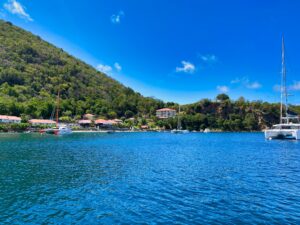
The anchorage of Pain de Sucre on Iles des Saints.
The original plan was to somehow sail to the Canary Islands after visiting the Bijagos and from there back to the Azores. But there was simply no weather window that would have allowed us to head north-east. On the contrary: the wind blew with frustrating consistency from precisely this direction. I could have waited until April for favourable weather to sail directly to the Azores. But I had already been in Cape Verde for far too long. I had to do something.
„While you’re here,“ said Katrin, my wife, over dinner in one of Mindelo’s cute little restaurants. She thought it would be a good idea to let me sail to the Caribbean. So that could be crossed off the bucket list, she added. To make it easier for me, she also organised a companion: I had met Devi in Mindelo. The 54-year-old had been travelling on a Polish boat. Katrin suggested that she change boats and sail with me. Which she did.
Changeable winds
So, on 1 February, the two of us set off westwards. Around 2100 nautical miles lay ahead of us. The Atlantic initially greeted us with strong gusts and somewhat rough seas. But the wind soon died down a little and we had days of slow sailing ahead of us. At first I tried the Roundsail, a parachute converted into a light wind sail. But even that didn’t have enough wind. The parachute ended up in the water twice.
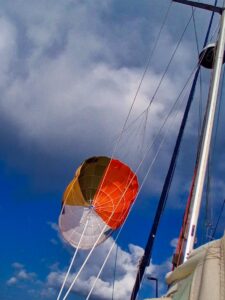
The roundsail.
I therefore switched to the standard passat sail with the mainsail on one side and the unfurled genoa on the other. Blue Alligator liked this and the wind pilot took over the steering. We kept this arrangement until we made landfall in Martinique. Almost everything went by itself.
Minor and major damage
I think the question on an Atlantic crossing is more about what breaks, not whether something breaks. We were lucky. Most of the damage was minor, such as the drive belt of the electric autopilot or a steering line of the wind pilot. In Mindelo, I had the guide for the genoa furling repaired and a new halyard fitted. After a few days, I realised that the knot on the halyard had come loose. From then on I could no longer unfurl the genoa completely, otherwise it would have simply come down. But now that the wind had finally picked up, we were sailing with reefed sails anyway.
Less harmless was the breakage of a bolt holding one of the lower shrouds, that hold the mast. Fortunately this happened during the light wind phase. I don’t know if the mast would have held if the shroud had come loose in more wind and waves. So we had time to repair it. But of course I didn’t have a spare bolt on board. It’s always the same: what you least think about breaks.
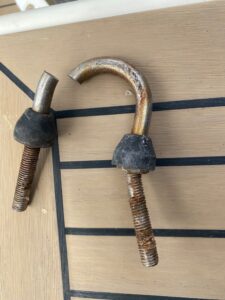
The broken bolt.
Fortunately, Blue Alligator has a lot of things fitted on board that are not essential. We therefore removed a bolt from another location and replaced the broken piece. After two hours of hard work and a few more bruises (I had to squeeze into the wardrobe to tighten the bolt), the repair was complete. And at least two replacement bolts were added to the shopping list.
The daily flying fish
Apart from that, the trip was more or less uneventful. We only saw dolphins at the end. Instead, dozens of flying fish landed on deck. With one exception, the elegant, shimmering blue animals with their wing fins did not survive the landing and so we collected the dried-up corpses in the morning.
After about a week, we found it difficult to determine the day of the week, and after two weeks we had to use the logbook if we wanted to know how long we had been at sea. To prevent the days from becoming monotonous, we made dinner the highlight of the day. However, we forgot to tell the time and so the further west we sailed, the higher the sun rose. Surprisingly, the fresh supplies – tomatoes, cucumbers, carrots, cabbage – lasted almost all the way to the other side of the ocean. Our dishes became increasingly vegetarian. But that didn’t detract from them.
Arrival in Martinique
We reached Martinique on 19 February and moored in the Le Marin marina. We felt amazingly good, but also relieved to have made it. Mooring in the marina was the most stressful time we’d had in a long time.
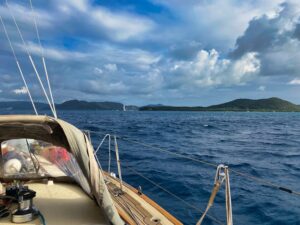
Arriving on Martinique.
It’s hard to say what an Atlantic passage on a relatively small boat does to you. Pride? Perhaps. I’ve certainly become a little more relaxed and gained more confidence in my own abilities and the boat. But the special thing was probably the experience of time and how much everything else that usually makes up life loses meaning when you are surrounded by nothing but an ocean. I could just sit and watch the waves for hours. Strangely enough, I never got bored.
Or I would listen to the dialogue between Aeolus and Neptune, as a friend who had crossed the Atlantic before us had put it. Sometimes the two seemed to be arguing. Then the dialogue was more of a whisper. In any case, the two of them carried us forward, during the day under an ever-hotter burning sun, at night under a fantastic starry sky. We felt small in this universe – and yet our boat, with its ten metres, seemed sufficient. In the end, size is relative anyway.
Nevertheless, three weeks is a long time. And it will take at least as long to sail from the Caribbean back to the Azores. What’s more, the journey from west to east is more unpredictable. While we were more or less able to rely on the trade winds on the journey to the Caribbean, the return journey will depend on various weather systems. So it should be more exciting.
